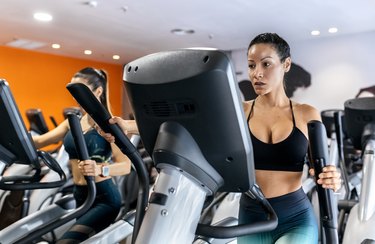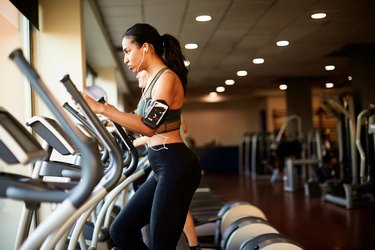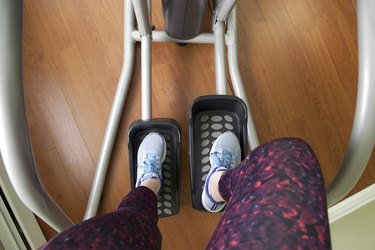
One of the most confusing parts about working out? It's not a one-size-fits-all kind of thing. One of the best parts about working out? It's not a one-size-fits-all kind of thing. Translation: You can (and should) customize your workouts to fit your goals.
So when it comes to the best elliptical resistance levels, there isn't just one setting that works for every cardio session, according to Mathew Forzaglia, CPT, a certified personal trainer and founder of Forzag Fitness on the NEOU App. It all comes down to your goals and fitness level — and with cardio equipment, it also depends on the specific machine you're using.
Video of the Day
Video of the Day
What Resistance Is Best on an Elliptical?
The answer depends on your goals. If you want to improve your endurance, you need a moderate, comfortably challenging elliptical resistance level. But if you want to build strength, you need to work at a higher intensity, meaning heavier resistance. And for weight loss, a combination of the two is ideal.
Find the range of levels on your machine and choose the best resistance from there. For instance, if your machine goes from level 1 to 10:
- 4 to 6 is probably best for building endurance
- 7 to 10 is probably best for building strength
Elliptical Resistance for Improving Endurance
To improve your aerobic fitness, you want to keep the resistance at a level you can sustain for longer periods of time. You want the workout to feel comfortably challenging, increasing your breathing and heart rate.
Using Target Heart Rate
To benefit your heart health, you should try to train within your aerobic zone, which is between 65 and 75 percent of your maximum heart rate (MHR), according to the Centers for Disease Control (CDC). You can calculate your MHR by subtracting your age from 220.
To get your target heart rate zone, multiply that number by 0.65 and 0.75. This is your aerobic zone. The easiest way to stay within this zone is by using a heart rate monitor on a fitness watch or the elliptical itself. And your target resistance level should be whatever helps you stay in this zone.
Using Rate of Perceived Exertion
But if you don't have a fitness watch or heart rate monitor, you can also use your rate of perceived exertion (RPE). RPE helps you measure how hard you're working during a training session, according to the CDC.
This scale ranks effort from 6 to 20 — the lower end of the scale is little effort, and the highest level is maximum effort. To improve your cardiac health, you want your workout to feel moderately challenging, which is between levels 12 and 14.
Elliptical Resistance for Building Strength
When it comes to building strength, resistance is key, according to Forzaglia. In order to gain strength, you need to use progressive overload, which involves continually challenging your muscles over time.
When you work out, you cause damage to your muscle fibers. Then, during the recovery process, your body rebuilds the damage, leaving stronger and thicker fibers in their place. The stronger your muscle fibers, the stronger your muscles.
On the elliptical, that means you have to increase the resistance from one training session to the next, Forzaglia says. You want your workout to feel challenging, and usually, that involves setting the elliptical to a resistance that's on the higher end of machine's scale.
A good rule of thumb? You shouldn't be able to hold a consistent pace for too long. Instead, focus on intense intervals of 20 to 45 seconds of work, Forzaglia recommends. Week after week, gradually increase the resistance.
Elliptical Resistance for Weight Loss
For overall weight loss, Forzaglia recommends a combination of the two methods above. Your elliptical workouts should vary between long aerobic sessions and short, high-resistance bouts.
That doesn't necessarily mean you need to combine both of these training styles in the same workout (though you can). It comes down to what you prefer. Those who have more time to devote to exercise can do cardio-focused workouts one day, followed by strength-dominant training the next.
But if you can only hop on the elliptical once a week, you can do moderate-intensity intervals mixed with higher resistance.
Adjusting Your Elliptical
Different ellipticals have different resistance levels, so the specific numbers for each fitness goal will vary. To find your ideal elliptical resistance level, toggle the switches or buttons on the machine to get an idea of how many levels are available.
The lower the number, the lower the resistance and the higher the number, the higher the resistance. Higher resistance levels feel more challenging and demand more effort, while lower levels are easier to maintain.
Once you find the machine's range of resistance levels (for instance, many go from level 1 to 10), adjust accordingly based on your goals (see above). If your machine ranges from 1 to 10, levels 4 through 6 are probably best for endurance training and levels 7 through 10 are best for building strength.
As mentioned above, it's not "one size fits all." So feel free to adjust your preferred levels as you train on the machine.
Was this article helpful?
150 Characters Max
0/150
Thank you for sharing!
Thank you for your feedback!


